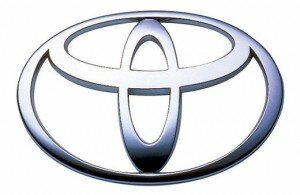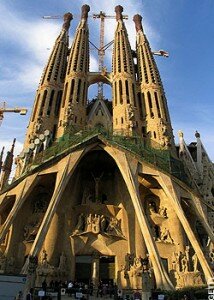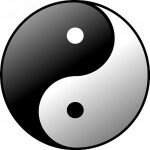Archive for the ‘Marketing’ Category
Does happiness have anything to do with business?
Described elsewhere as the “happiest man in the world,” Tibetan Buddhist master Yongey Mingyur Rinpoche reminds his audience what we inherently know and usually forget: Happiness lies within.
I heard Yongey Mingyur speak at a recent Portland State University event on “sustainable happiness.” As a sustainability advocate and a sometimes meditator, I couldn’t resist attending.
We in the US might want to listen to what Yongey Mingyur has to say. Despite being a country that enshrined the pursuit of happiness in its Declaration of Independence, the US ranks down most lists of the happiest countries. Probably not surprising given how we’ve managed to conflate happiness with having or buying more things.
A 2,500-year-old practice mastered by the likes of Yongey Mingyur suggests the cultivation of mindfulness as an alternative path to happiness. And what happens to be on my mind as I blog today is this: Does happiness have anything to do with business?
Fair question, it seems, given the ongoing economic upheaval. These are hard times in many workplaces. Employees who withstood layoffs now asked to do more. Wage rollbacks or miniscule raises. Desperate competitors slashing prices and everyone’s profit margins. And now, worry about a double-dip recession. What’s there to be happy about — other than still being in business or having a job?
In my experience as a business owner, consultant and employee, happiness eludes most businesses even in the best of times. Best, in this case, means periods of rapid revenue and profit growth. It’s the rare company in the midst of a boom cycle that declares, “Enough. We’re happy with what have.” Most cling to the notion that if your business isn’t growing, it’s dying.
Survival of the paranoid
In good times and bad, business is a practice in survival. And as Andy Grove, founder of one of the world’s most successful companies, Intel, famously asserts, “Only the paranoid survive.” He may have a point. Intel CEO Paul Otellini last month declared Q2 2010 “the best quarter in the company’s 42-year history.” And that’s in the midst of the Great Recession!
So should we be nurturing “Intel Inside” all of our businesses, rather than happiness? If we did, we might find the company voice within sounding something like Andy Grove when he writes:
Business success contains the seeds of its own destruction. The more successful you are, the more people want a chunk of your business and then another chunk and then another until there is nothing left. I believe that the prime responsibility of a manager is to guard constantly against other people’s attacks and to inculcate this guardian attitude in the people under his or her management.
Not exactly a happy-sounding voice. But maybe happiness is something we pursue only in our off hours. And maybe Nirvana’s Kurt Cobain was speaking for business when he sang: “Just because you’re paranoid don’t mean they’re not after you.”
FUD instead of happiness?
Or maybe we should be listening to Yongey Mingyur whose tradition maintains: “The basic concern shared by all beings—humans, animals, and insects alike—is the desire to be happy and to avoid suffering.”
We don’t avoid suffering by inviting fear and paranoia to rule our lives. Why would it be any different in business?
Truth is, we’re not very practiced at cultivating happiness, at work or outside of work. In fact, we’re much more skilled at sowing fear, uncertainty and doubt. In business parlance, it’s simply called FUD. Surround your competitors with FUD so your customers are more apt to choose you. Contrary to human nature, business doesn’t avoid FUD; it rewards it!
So back to my question: Does happiness have anything to do with business? Sure. We all want delighted customers. Even Andy Grove. And yet how many of us believe the purpose of business is to help others—customers, employees, partners, neighbors—be happy? I’m guessing, not many. In other words, happiness doesn’t have that much to do with business.
What if…
What if business was all about happiness? What if we were to follow the lead of the happy country of Bhutan, as hotelier and author Chip Conley recommended in his recent TED talk, and create “a habitat for happiness” in our businesses?
For starters, we might catch up with our customers, more of whom are realizing the futile chase for happiness through more stuff. As the New York Times reported this month, more Americans are responding to today’s economic realities by simplifying their lives, spending more on experiences than possessions and generally getting in touch with what really matters, like relationships with family and friends.
So what do you think? Does business have any business cultivating happiness? Or is it true, only the paranoid survive?
Imagining the ‘Sustainable Communicator’
Based on the scale of green marketing we see across all media today, you’d think the practice of sustainability is spreading like wildfire throughout business. And you’d be wrong.
I was reminded of the green vs. sustainability disparity as I was preparing a talk I gave last week to the Communicators Conference in Portland, Ore. In the talk I outlined a vision for what I called the “Sustainable Communicator.”  If this vision came to pass today, I believe we’d see an immediate ratcheting back on the practice of green marketing and a spike in the practice of sustainability.
If this vision came to pass today, I believe we’d see an immediate ratcheting back on the practice of green marketing and a spike in the practice of sustainability.
Let me explain.
First, consider these two studies from 2009:
- In its study entitled “The Road Not Yet Taken,” the Sustainable Enterprise Institute reviewed the public information disclosed by companies in the Russell 1000 Index and concluded: “evidence of any broad spectrum adoption of sustainable business practices is not to be found.”
- The Boston Consulting Group and MIT Sloan Management Review surveyed 2,000 business leaders worldwide as part of their study called “The Business of Sustainability.” The authors reported “a material gap between intent and action at most companies” they examined.
Which begs the question, if business is so slow to embrace sustainability, how can there be so much green marketing? I believe the explanation is this: Sustainability and green are two different concepts. They are not interchangeable. As The Natural Step Network tells us in their workshops, green is focused on details, tactics, environment and “less bad.” Sustainability is focused on whole systems, strategy, triple bottom line (not just the environment) and aligning with nature’s cyclical processes.
Retire green marketing
If I had my way, I’d retire green marketing, as I argued in a previous post. Green marketing in business is first and foremost product marketing. And as we know, you don’t have to be a sustainable business to produce a “green” product.
As the studies above indicate, businesses that adhere to the principles of sustainability and operate from a triple-bottom-line (people, planet, profit) philosophy are uncommon. That means the majority of “green” products are produced, marketed and/or sold by companies that fall far short of the sustainability ideal.
I’m not opposed to green products. We need more of them. But relying on otherwise brown companies to produce green products is at best a “less bad” situation (and clearly the primary reason for greenwashing). If we are to solve the pressing social and environmental issues of our time — clean water, peak oil, over-consumption, income inequity, population growth, climate change — we need businesses fully on board with sustainability.
Fusing brand, culture, sustainability
And here’s where the Sustainable Communicator comes in. This mythical professional fuses the practices of branding, culture change and sustainability into something completely new.
The Sustainable Communicator is a result of a fundamental shift in focus and responsibility:
- from marketing green products to building sustainable businesses
- from creating brand image to living your brand
- from specialist in communications to leader in sustainability, organizational development and branding
Yes, the Sustainable Communicator remains an expert in communications. That goes without saying. She is also a leader in sustainability, triple-bottom-line management, culture change and collaboration.
I admit this is a tall order and unrealistic in the short term. But if business is going to be truly sustainable, it needs new leaders to emerge in all disciplines, including communications. Because we know there’s a significant gap between what business intends to do and what it’s actually doing in the areas of social and environmental responsibility.
The need to close this gap is the impetus behind my firm’s recent formation of the Sustainable Branding Collaborative and 4D Branding process.
Closing the intent vs. action gap
Communications professionals have a major role to play here. We can’t continue green marketing and pretend the gap doesn’t exist. The buck stops with us, as storytellers, to only share what we know to be true and to accurately reflect where our companies are along the path of sustainability.
But storytelling alone is too passive, too removed from the ultimate need of businesses to move farther and faster toward become truly sustainable. The Sustainable Communicator is more than a storyteller. She’s a hands-on leader in transforming business. And it’s in that experience she recognizes green marketing is a thing of the past.
There’s no disguising an unsustainable business
Apologies to the duck, but if it looks like an oil company, drills like an oil company, and speaks like an oil company, then it’s probably an oil company. And no amount of green costuming can disguise its true brown nature, especially when the promise of its “product” is now a potential ecological and economic disaster.
In the past decade, BP has positioned itself as a progressive global corporation — beyond petroleum, it would have us believe. In reality, it’s a gigantic oil company that, despite its energy diversifications, is determined to keep feeding our insatiable carbon appetite and making billions for it and its shareholders along the way.
To BP and any other business in an inherently dirty industry, spare us the green preening. A fossil fuel business is not sustainable, OK? 
If only BP would be so honest. Instead it continues to lead with a brand — symbolized by a logo inspired by the Greek god of the sun and bathed in pastoral green — that implies its core value is sustaining life for the planet and all its inhabitants.
Branding consultant Lisa Merriam tells it like is:
“The much-admired green sun BP brand died this week. This is a brand that never left the marketing department. No matter what they said the company stood for, they never lived it. Despite all those smug ads about wind farms and being ‘Beyond Petroleum,’ this shows they are just like any other oil company — their green brand is as dead as all of the wildlife washing up on Louisiana shores.”
While I side with Merriam on this one, the reality is BP’s green reputation hasn’t been warranted for some time, if ever. In April 2008, Sustainable Industries magazine, citing an anonymous source, reported:
(A) top-down decision has been made to pull away from touting any “green” initiatives in the media, and in fact major “green” advertising buys have been canceled. Recent press releases focus not on alternative energy successes as they did in (former CEO Lord) Browne’s time, but on BP’s ability to keep pumping oil, maintain its oil reserves and safely conduct deep-water oil drilling.
A look at the advertising BP features on its website seems to bear this out. Beyond petroleum isn’t an environmental message; it’s an energy security message, as copy in this current BP ad illustrates:
To enhance America’s energy and economic security, we must secure more of the energy we consume. That means expanding the use of wind, solar and biofuels, as well as opening new offshore areas to oil and gas production.
BP doesn’t tout alternative energy sources to help reduce global warming — an environmental message. In fact, it clearly is trying to sway public opinion in favor of allowing more offshore drilling — a decidedly non-green initiative.
While BP isn’t hiding its desire to extract and sell lots more oil, it wants to have its cake and eat it, too: lead with energy security and have us believe it also cares about the environment. Consider this BP advertising headline, “Hydrocarbons and low carbons living in harmony.” Right. And Monsanto has some genetically modified seeds to sell you organic farmers.
BP’s website has the obligatory environmental and society sections, giving the impression of their planetary concern. But look closely at BP’s statement on sustainability:
At BP we define sustainability as the capacity to endure as a group, by:
- Renewing assets
- Creating and delivering better products and services that meet the evolving needs of society
- Attracting successive generations of employees
- Contributing to a sustainable environment
- Retaining the trust and support of our customers, shareholders and the communities in which we operate.
Hardly the rhetoric of a company committed to advancing social and environmental health through its company operations. What it tells me is BP cares most about staying in business — “to endure as a group.” The closest it comes to an environmental promise — “contributing to a sustainable environment” — is so vague as to be laughable.
BP’s two-faced approach should not be dismissed as just another instance of greenwashing. It feels more insidious, a cleverly disguised deceit on a global scale. Its incessant search for oil — even in 5,000-foot waters in the Gulf of Mexico — puts BP anywhere but “beyond petroleum.” In the name of “energy security,” BP is willing to risk the kind of ecological calamity now threatening the Gulf region. That is not a risk a sustainable company takes.
The day BP stops drilling is the day I’ll start listening. Until then, let’s make no mistake about the kind of company BP is.
Sustainable branding: Promise is only half the story
“Promises are like babies,” an unknown author once said. “Easy to make, hard to deliver.”
Sounds like a good reason to never make a promise. Or better yet, good reason to think long and hard before making one.
Countless branding books and consultants describe a brand as a promise. That’s an inside-out view. If I’m on the outside looking at your business, I don’t care whether you make a promise. I care whether you keep it.  My guess is millions of Toyota owners feel similarly today about that company’s promise of quality.
My guess is millions of Toyota owners feel similarly today about that company’s promise of quality.
Promises have no value until or unless they’re consistently fulfilled. That gets lost among many who make their living in branding, communications and design. I used to be among them. Branding meant communicating a promise and persuading others to pay attention. If I did that well, I was doing my job.
My certainty about all of this gave way as I delved deeper into sustainability and carved out a sustainable branding practice. Everywhere it seemed, marketers were jumping onto the green marketing bandwagon. Meanwhile, consumer complaints of “greenwashing” kept growing as marketers used one hand to paint their companies or products green and the other to cover their eyes to the brown.
Words and deeds
Sustainable branding is not simply marketing communications by another name. It’s aligning what you stand for as a business with what people experience from you. Greenwashing does the opposite: It misaligns words and deeds.
Companies have been saying one thing and doing another forever. What’s changed is the technology and desire to call them out. Social media tools such as Twitter and Facebook and user-generated sites such as Yelp will expose hypocritical businesses in a heartbeat. And nowhere is the B.S. radar on higher alert than when a company speaks of social or environmental responsibility. People may overlook the advertisement that overstates a product’s benefits. But many can’t wait to bust the company that promises — and fails — to do good.
Carefully researched, considered and cultivated, a brand moves a business toward competitive distinction and customer relevance. Unfortunately, most businesses leave brand management to marketing communications. They equate branding with names, logos, taglines, messages, advertising campaigns and a consistent “look & feel.”
Where the buck stops
What our businesses say and how we look matters when separating ourselves as a brand. But not nearly as much as what we do as a business.
Want your brand to stand out from the crowd? Then let your actions do more of the talking. Nothing communicates as convincingly as a company whose employees, culture and operations consistently deliver a distinct, relevant product, service or experience.
This doesn’t happen by accident. It requires a CEO and senior managers who ensure their company walks it talk. Unless your marketing department runs the company, the branding buck must stop with the people who have ultimate authority to motivate, train or cajole everyone to deliver on the company’s core promise.
Stepping onto the path of sustainability makes this more imperative than ever.
When you pledge to build a more sustainable company, it’s like handing a magnifying glass to your customers, employees and other stakeholders and inviting them to inspect your every move. Witness the emergence of greenwashing watchdogs.
Living the brand
The prospect of greater scrutiny frightens some executives. Others say bring it on. They know integrity and accountability have always been hallmarks of great companies. And they don’t fear the added weight of social and environmental responsibility that a commitment to sustainable business practices demand. They’re simply trying to do the right thing.
But even their firms may need help living their brands. That’s why I’ve formed a team of experts in organizational development, sustainability, research, design and storytelling.
I look forward to sharing more about our collaboration soon. But you can be sure we’re clear on one thing: Making a promise is the easy part of branding. It’s the delivery we need to worry about.
The sustainable virtues of slow brand
This may be the first and only time you see the words “cathedral thinking” and “slow brand” used in the same sentence. Allow me to explain.
Last week I heard New York Times journalist Andrew Revkin refer to cathedral thinking as he spoke of his reporting on the daunting ecological challenges that confront us all. The effort needed to prevent the worst from happening will take enormous long-term commitment. The kind that compelled generations of humans past to build great religious monuments over decades, even centuries, knowing they would never experience the full fruits of their labor.

Gaudi Cathedral
I think of the Gaudi Cathedral in Barcelona, whose construction began in 1882 and continues today — 127 years later and 83 years after the death of its famed architect Antoni Gaudi.
I suppose only someone like me would ponder branding as Revkin spoke. I jotted down on my notepad the words slow brand. I had never seen or heard those two words used together, although a subsequent web search shows at least one blog by the name.
There are emerging slow food and slow money movements, but no slow brand movement. That’s understandable. Who in business wants “slow” to describe anything about them?
Painstakingly constructing a cathedral is no metaphor for how most companies and their brands are built. In the hyper-competitive world of business, speed is of the essence. We don’t know where we’re going, but we’re going there fast. We want a brand — stat!
Fast brand, slow brand
Companies that embrace the principles of sustainability will quite naturally take their foot off the accelerator. Sustainability requires a fundamental restructuring in how we conduct business. By holding itself accountable for the environmental and social impacts of its actions, a sustainable business doesn’t take shortcuts to success.
How we build our company brand matters. Weak ones are little more than facades. At best their value is aesthetic. Good ones are strong foundations. They allow businesses to stand the test of time because they’re solid, substantial, dependable, built with a sense of purpose and a whole lot of sweat equity. For me this describes slow brand — not a type of brand, but an approach to building a brand that gains strength over time.
How does slow brand compare with fast brand? Let me take a crack at drawing some distinctions:
- Fast brand is led by marketing. Slow brand is led by mission. Fast brand is isolated to marketing. The rest of the company pays it little or no attention. Slow brand supports the mission of a company, its reason for being. Just as a mission’s accomplishment requires an entire company, so does the building of a brand.
- Fast brand is how we look. Slow brand is who we are. Fast brand is obsessed with appearance: cool, innovative, powerful, smart. Slow brand is committed to substance. Integrity matters above all.
- Fast brand is a promise communicated. Slow brand is a promise fulfilled. Fast brand reduces itself to messages delivered by creative marketers. Slow brand knows a company’s actions speak louder than its words.
- Fast brand is purchased. Slow brand is earned. Fast brand loves media plans: broadcast, social, print. It works inside-out. Slow brand loves satisfied customers, employees and other stakeholders. It works outside-in.
Putting the CEO in charge
The longer I work at the intersection of branding and sustainability, the more convinced I am that brand ownership cannot be left to a marketing team. Ultimate brand responsibility must rest with the CEO. This is especially important for a business that’s making sustainability a brand cornerstone — a so-called sustainable brand. Stating a commitment to sustainability heightens the expectations of a company’s practices. And only the CEO is positioned to ensure every employee fulfills the promise of sustainability inherent in the mission and brand.
If your business is striving for sustainability, you know the transition won’t happen overnight. It will take concentrated effort over a long period of time. You may not be building a cathedral, but it may help to think you are.



